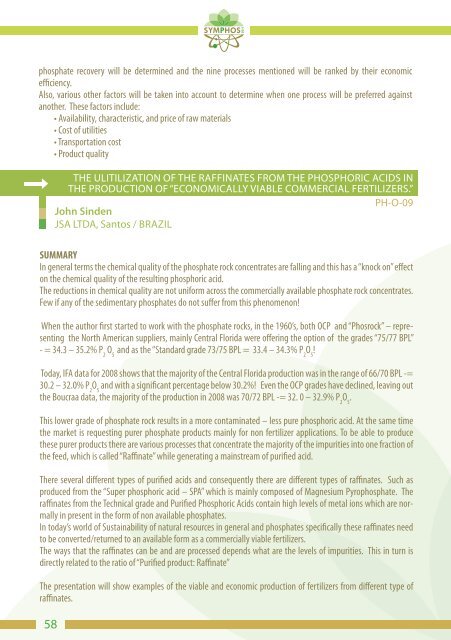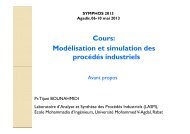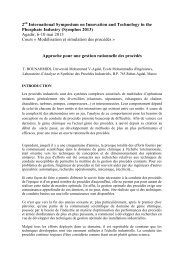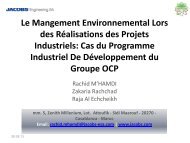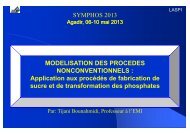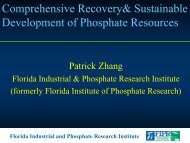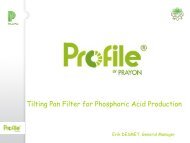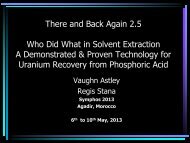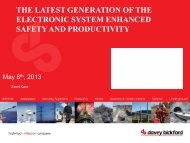Abstract SYMPHOS 2011
Abstract SYMPHOS 2011
Abstract SYMPHOS 2011
You also want an ePaper? Increase the reach of your titles
YUMPU automatically turns print PDFs into web optimized ePapers that Google loves.
phosphate recovery will be determined and the nine processes mentioned will be ranked by their economic<br />
efficiency.<br />
Also, various other factors will be taken into account to determine when one process will be preferred against<br />
another. These factors include:<br />
• Availability, characteristic, and price of raw materials<br />
• Cost of utilities<br />
• Transportation cost<br />
• Product quality<br />
58<br />
THE ULITILIZATION OF THE RAFFINATES FROM THE PHOSPHORIC ACIDS IN<br />
THE PRODUCTION OF “ECONOMICALLY VIABLE COMMERCIAL FERTILIZERS.”<br />
John Sinden<br />
JSA LTDA, Santos / BRAZIL<br />
PH-O-09<br />
SUMMARY<br />
In general terms the chemical quality of the phosphate rock concentrates are falling and this has a “knock on” effect<br />
on the chemical quality of the resulting phosphoric acid.<br />
The reductions in chemical quality are not uniform across the commercially available phosphate rock concentrates.<br />
Few if any of the sedimentary phosphates do not suffer from this phenomenon!<br />
When the author first started to work with the phosphate rocks, in the 1960’s, both OCP and “Phosrock” – representing<br />
the North American suppliers, mainly Central Florida were offering the option of the grades “75/77 BPL”<br />
- = 34.3 – 35.2% P 2 O 5 and as the “Standard grade 73/75 BPL = 33.4 – 34.3% P 2 O 5 !<br />
Today, IFA data for 2008 shows that the majority of the Central Florida production was in the range of 66/70 BPL -=<br />
30.2 – 32.0% P 2 O 5 and with a significant percentage below 30.2%! Even the OCP grades have declined, leaving out<br />
the Boucraa data, the majority of the production in 2008 was 70/72 BPL -= 32. 0 – 32.9% P 2 O 5 .<br />
This lower grade of phosphate rock results in a more contaminated – less pure phosphoric acid. At the same time<br />
the market is requesting purer phosphate products mainly for non fertilizer applications. To be able to produce<br />
these purer products there are various processes that concentrate the majority of the impurities into one fraction of<br />
the feed, which is called “Raffinate” while generating a mainstream of purified acid.<br />
There several different types of purified acids and consequently there are different types of raffinates. Such as<br />
produced from the “Super phosphoric acid – SPA” which is mainly composed of Magnesium Pyrophosphate. The<br />
raffinates from the Technical grade and Purified Phosphoric Acids contain high levels of metal ions which are normally<br />
in present in the form of non available phosphates.<br />
In today’s world of Sustainability of natural resources in general and phosphates specifically these raffinates need<br />
to be converted/returned to an available form as a commercially viable fertilizers.<br />
The ways that the raffinates can be and are processed depends what are the levels of impurities. This in turn is<br />
directly related to the ratio of “Purified product: Raffinate”<br />
The presentation will show examples of the viable and economic production of fertilizers from different type of<br />
raffinates.


